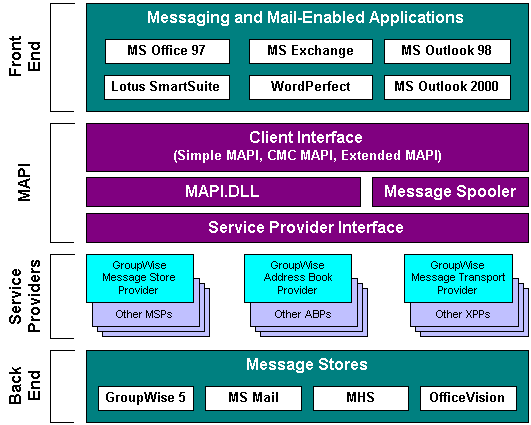1.0 Overview
The Messaging Application Programming Interface (MAPI 1.0) is a set of object-oriented functions that provide messaging capabilities. Mail-enabled applications use MAPI to create, transfer, and store messages, as well as handle complex addressing information. MAPI objects are data structures that support a set of properties and comply with the OLE component object model (COM), which requires that objects support one or more interfaces, or sets of functions. For more information about MAPI, see the MAPI Programmer’s Guide.
GroupWise offers extensive MAPI support by:
-
Interfacing with the Microsoft Exchange client.
-
Interfacing with mail-enabled MAPI applications such as WordPerfect, Microsoft Office 97, and Microsoft Outlook 98 and 2000.
-
Supporting all MAPI clients.
This section covers the following topics:
Figure 1-1 MAPI Overview

As illustrated above, MAPI allows messaging applications and mail-enabled applications to have direct access to service providers. Messaging functions are called from the MAPI client interface. The MAPI DLLs act as an object handler by selecting the provider and exposing objects to the client interface. Various messaging operations can be performed by calling methods in the exposed object.
Each service provider performs its functions according to a supporting messaging service which can include multiple message stores, address books, and transport providers. MAPI selects among message stores and transport providers as necessary. Multiple address books appear independent of one another in the client, allowing the user to randomly choose among them.
The message spooler controls MAPI activities that run independently of the messaging application. The spooler works closely with the message stores and transport providers when transferring messages. Because the spooler monitors its activities internally, it is transparent to the client interface.